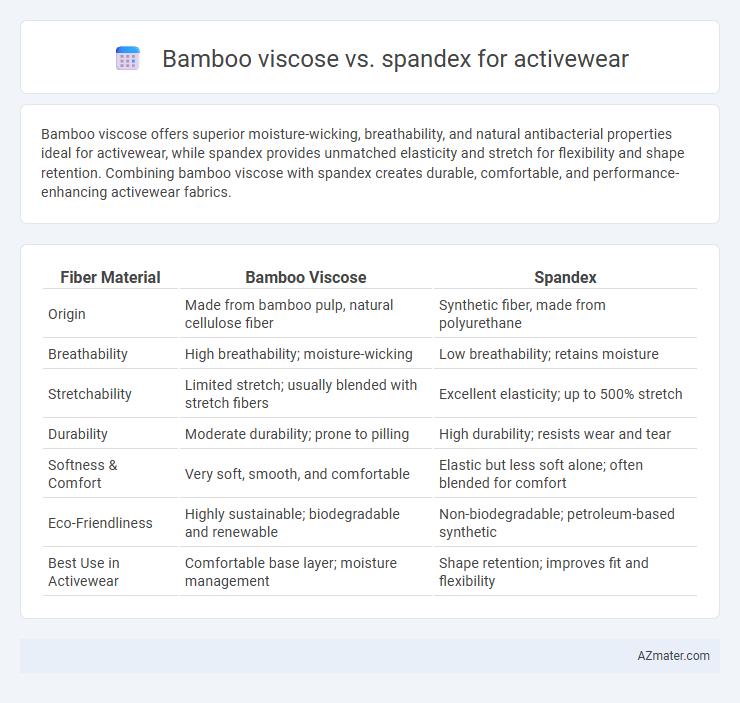Bamboo viscose offers superior moisture-wicking, breathability, and natural antibacterial properties ideal for activewear, while spandex provides unmatched elasticity and stretch for flexibility and shape retention. Combining bamboo viscose with spandex creates durable, comfortable, and performance-enhancing activewear fabrics.
Table of Comparison
| Fiber Material | Bamboo Viscose | Spandex |
|---|---|---|
| Origin | Made from bamboo pulp, natural cellulose fiber | Synthetic fiber, made from polyurethane |
| Breathability | High breathability; moisture-wicking | Low breathability; retains moisture |
| Stretchability | Limited stretch; usually blended with stretch fibers | Excellent elasticity; up to 500% stretch |
| Durability | Moderate durability; prone to pilling | High durability; resists wear and tear |
| Softness & Comfort | Very soft, smooth, and comfortable | Elastic but less soft alone; often blended for comfort |
| Eco-Friendliness | Highly sustainable; biodegradable and renewable | Non-biodegradable; petroleum-based synthetic |
| Best Use in Activewear | Comfortable base layer; moisture management | Shape retention; improves fit and flexibility |
Introduction to Bamboo Viscose and Spandex
Bamboo viscose is a sustainable fabric known for its breathability, moisture-wicking properties, and natural antibacterial qualities, making it ideal for activewear. Spandex, a synthetic fiber, offers exceptional stretch and recovery, providing flexibility and comfort during intense physical activities. Combining bamboo viscose with spandex creates activewear that balances softness, durability, and performance.
Material Origins and Manufacturing Processes
Bamboo viscose is derived from bamboo plants through a chemical process involving cellulose extraction and regeneration, creating a soft, breathable fabric with natural moisture-wicking properties ideal for activewear. Spandex, also known as elastane, is a synthetic fiber made from polyurethane, produced through a polymerization process that yields exceptional stretch and recovery for enhanced flexibility and support in athletic clothing. The natural origin of bamboo viscose contrasts with the entirely synthetic nature of spandex, influencing their environmental impact and fabric performance in activewear applications.
Moisture-Wicking and Breathability Comparison
Bamboo viscose excels in moisture-wicking and breathability due to its natural fiber structure, which effectively draws sweat away from the skin while allowing air circulation to keep the wearer cool and dry. Spandex, while offering superior stretch and shape retention, has limited moisture-wicking capabilities and tends to trap heat, reducing overall breathability. Combining bamboo viscose with spandex in activewear fabric blends enhances comfort by balancing moisture management with flexibility.
Comfort and Fit: Which Feels Better?
Bamboo viscose offers superior breathability and moisture-wicking properties, making it exceptionally comfortable for activewear by keeping skin dry and cool during intense workouts. Spandex provides unmatched stretch and recovery, ensuring a snug, supportive fit that moves seamlessly with the body. Combining bamboo viscose's softness with spandex's elasticity often results in activewear that feels both comfortable and perfectly fitted.
Stretch and Flexibility Differences
Bamboo viscose offers moderate stretch and breathability but lacks the high elasticity found in Spandex, making it less ideal for tight-fitting activewear requiring extensive movement. Spandex, known for its exceptional stretch retention and flexibility, can elongate up to 500%, providing superior support and shape recovery during intense physical activity. Combining bamboo viscose with a small percentage of Spandex often results in activewear that balances softness, moisture-wicking properties, and enhanced stretch performance.
Durability and Longevity in Activewear
Bamboo viscose offers natural breathability and softness but tends to have lower durability compared to spandex, which excels in elasticity and resistance to wear and tear. Spandex fibers provide superior stretch retention, making activewear more resilient to frequent movement and repeated washing. Combining bamboo viscose with spandex blends enhances both comfort and longevity, optimizing performance in activewear fabrics.
Sustainability and Environmental Impact
Bamboo viscose offers a sustainable alternative to synthetic fibers, as it is derived from bamboo, a fast-growing, renewable resource requiring minimal pesticides and water, making it eco-friendly for activewear. Spandex, while providing superior stretch and flexibility, is petroleum-based and non-biodegradable, contributing to plastic pollution and higher carbon footprints in activewear production. Choosing bamboo viscose over spandex significantly reduces environmental impact, promoting biodegradable, renewable material usage in sustainable activewear manufacturing.
Odor Resistance and Antimicrobial Properties
Bamboo viscose fibers possess natural antimicrobial properties and excellent odor resistance due to inherent bio-agents that inhibit bacterial growth, making them highly suitable for odor-prone activewear. In contrast, spandex, primarily a synthetic elastane fiber, lacks intrinsic antimicrobial capabilities and relies on treatments or fabric blends to achieve similar odor control. Bamboo viscose's eco-friendly production and superior breathability enhance comfort and hygiene during intense physical activities, outperforming spandex in odor management and microbial resistance.
Care and Maintenance for Each Fabric
Bamboo viscose activewear requires gentle washing in cold water and air drying to maintain its softness and moisture-wicking properties, avoiding bleach and fabric softeners to prevent fiber damage. Spandex activewear demands careful care by hand washing or using a delicate cycle with mild detergent, avoiding high heat in drying to preserve its stretch and elasticity. Proper maintenance extends the lifespan of both fabrics, with bamboo viscose benefiting from breathable storage and spandex requiring avoidance of rough surfaces that can cause pilling or snags.
Which Fabric Is Best for Your Workout?
Bamboo viscose offers superior moisture-wicking and breathability, making it ideal for low-impact workouts where comfort and natural fibers are prioritized. Spandex provides exceptional stretch and shape retention, enhancing mobility and support during high-intensity exercises or activities requiring a full range of motion. For balanced performance, blending bamboo viscose with spandex creates activewear that combines softness, odor resistance, and elasticity, optimizing workout comfort and durability.

Infographic: Bamboo viscose vs Spandex for Activewear
 azmater.com
azmater.com